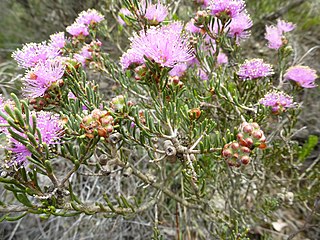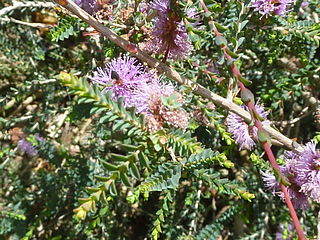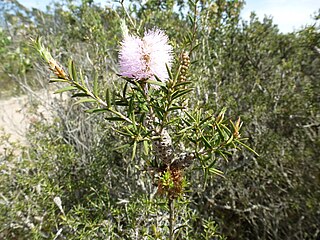
Melaleuca armillaris, commonly known as bracelet honey myrtle, is a plant in the myrtle family, Myrtaceae, and is native to South Australia, Victoria and Tasmania in south-eastern Australia. It is a hardy, commonly grown species, often used as a fast-growing screen plant, but it also has the potential to become a weed. It has become naturalised in Western Australia and parts of Victoria. In its natural state, it grows on coastal cliffs and along estuaries.

Calothamnus is a genus of shrubs in the family Myrtaceae and is endemic to the south-west of Western Australia. The common names one-sided bottlebrush or claw flower are given to some species due to their having the flowers clustered on one side of the stem or because of the claw-like appearance of their flowers. Calothamnus species are generally medium to tall woody shrubs with crowded leaves. In most species the leaves are crowded and linear in shape, and the flowers are usually arranged in dense clusters. The petals are small and fall off the flower soon after it opens but the stamens are long, numerous and usually bright red.

Melaleuca huegelii, commonly known as chenille honey-myrtle, is a plant in the myrtle family, Myrtaceae and is endemic to the south-west coastal areas of Western Australia. It has small, almost scale-like leaves and flower spikes sometimes more than 100 millimetres (4 in) long on the ends many of its branches.

Melaleuca viridiflora, commonly known as broad-leaved paperbark, is a plant in the myrtle family Myrtaceae, and is native to woodlands, swamps and streams in monsoonal areas of northern Australia and New Guinea. It is usually a small tree with an open canopy, papery bark and spikes of cream, yellow, green or red flowers.

Melaleuca cuticularis, commonly known as the saltwater paperbark is a tree in the myrtle family, Myrtaceae and is native to the south-west of Western Australia. There is also a disjunct population on Kangaroo Island in South Australia. It is distinguished from other melaleucas by its unusual fruits and very white, papery bark.

Melaleuca elliptica, commonly known as the granite bottlebrush is a plant in the myrtle family, Myrtaceae and is endemic to the south of Western Australia. The Noongar name for the plant is gnow. It is commonly grown in gardens because of its neat foliage and showy, bright red flower spikes although it needs to be pruned regularly to avoid becoming woody and untidy-looking. In nature, it usually grows in the shrub layer in mallee woodland or heath.

Melaleuca ericifolia, commonly known as swamp paperbark, is a plant in the myrtle family, Myrtaceae and the genus Melaleuca, native to south-eastern Australia. It is a rather variable species and some specimens resemble Melaleuca armillaris but its papery bark and smaller, more prolific flower heads distinguish it from that species. It often grows in swampy areas and the draining and clearing of these has reduced the numbers of the species, especially around Port Philip Bay near Melbourne. It is also similar to Melaleuca pustulata, a Tasmanian endemic, but that species only grows in dry heath.

Melaleuca squarrosa, commonly known as scented paperbark, is a plant in the myrtle family, Myrtaceae and is endemic to south eastern parts of Australia, especially Tasmania. It is an attractive shrub with dense foliage and arching branches and it flowers profusely in spring or early summer, bearing spikes of perfumed yellow to white flowers.

Melaleuca carrii is a plant in the myrtle family, Myrtaceae and is endemic to the south-west of Western Australia. It is a small shrub similar to Melaleuca pentagona, with "pom-pom" heads of pinkish flowers and sharply pointed leaves but it is generally smaller, lacks a groove in its leaves and retains its petals on the flowers for longer than that species.

Calothamnus sanguineus, commonly known as silky-leaved blood flower, is a plant in the myrtle family, Myrtaceae and is endemic to the south-west of Western Australia. The Noongar peoples know the plant as Boolgalla. It is an erect to spreading shrub with short, cylindrical leaves and red or white flowers with an unusual arrangement of stamens, often flowering in autumn, winter or spring. It was the first of its genus to be formally described.

Melaleuca hypericifolia, commonly known as hillock bush, is a plant in the myrtle family, Myrtaceae, genus Melaleuca and is endemic to New South Wales in Australia. It has large, orange to red flower spikes and consequently is a commonly cultivated species. In 1797, James Edward Smith described the plant as:

Patersonia fragilis, commonly known as swamp iris or short purple-flag, is a species of flowering plant in the family Iridaceae family and is endemic to eastern Australia. It is a tufted perennial herb with linear, cylindrical leaves and pale violet to blue-violet flowers.

Melaleuca brevifolia, commonly known as mallee honey-myrtle, short-leaf honey-myrtle, or d'Alton's melaleuca is a shrub or tree in the myrtle family, Myrtaceae, and is native to western Victoria, south-eastern South Australia and the south-west of Western Australia. It is a shrub with rough, corky bark and a large number of heads of white to yellowish flowers on the previous season's growth. It is a moderately hardy garden plant.

Melaleuca gibbosa, commonly known as the slender honey-myrtle or small-leaved honey-myrtle is a plant in the myrtle family, Myrtaceae and is endemic to southern Australia. It is a dense, bushy shrub to about 2 metres (6.6 ft) with numerous slender, arching branches and oblong heads of mauve flower spikes in spring and sparsely throughout the year.

Melaleuca acuminata, commonly known as mallee honeymyrtle is a plant in the myrtle family, Myrtaceae and is native to Australia and widespread in temperate areas of the continent. It is an erect shrub to about 3 m (9.8 ft) usually found in mallee woodland.

Melaleuca pentagona is a plant in the myrtle family Myrtaceae and is endemic to the south of Western Australia. It is a showy, medium-sized shrub which produces large numbers of pink flowers in spring. There are three varieties recognised, one of which has been known in cultivation for many years.

Melaleuca striata is a plant in the myrtle family, Myrtaceae, and is endemic to the south of Western Australia. It has distinctive leaves and heads of pink to mauve flowers, usually in late summer.

Melaleuca suberosa, commonly known as corky-bark honey-myrtle or corky honeymyrtle, is a shrub in the myrtle family, Myrtaceae, and is endemic to the south of Western Australia. It is a distinctive shrub, recognised by its tiny, crowded leaves, corky bark and pink flowers that appear along lengths of leafless parts of the branches.

Melaleuca teretifolia is a plant in the myrtle family, Myrtaceae, which is endemic to the south-west of Western Australia. It is a shrub with long, thin leaves and clusters of usually white flowers along considerable lengths of the branches in late spring and summer.

Melaleuca thymoides is a plant in the myrtle family, Myrtaceae, and is endemic to the south-west of Western Australia. It is usually a low shrub. The ends of the branches usually end in a sharp spine and the leaves also have a sharp point. Bright yellow flowers appear on the ends of the branches in spring or early summer.




















